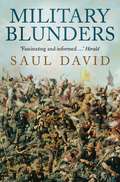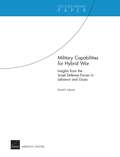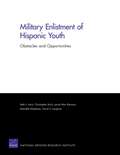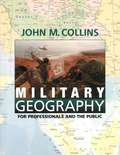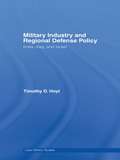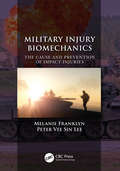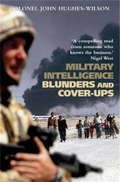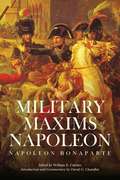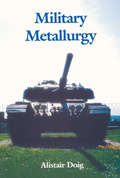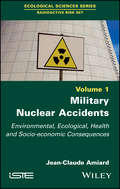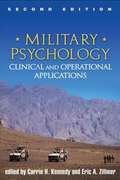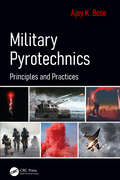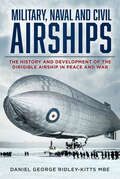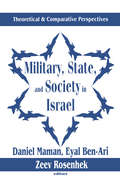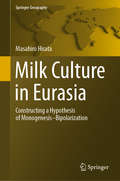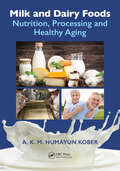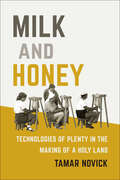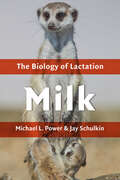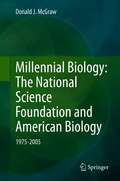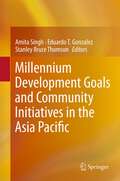- Table View
- List View
Military Blunders: The How And Why Of Military Failure
by Saul DavidRetelling the most spectacular cock-ups in military history, this graphic account has a great deal to say about the psychology of military incompetence and the reasons even the most well-oiled military machines inflict disaster upon themselves. Beginning in AD9 with the massacre of Varus and his legions in the Black Forest all the way up to present day conflict in Afghanistan it analyses why things go wrong on the battlefield and who is to blame.
Military Capabilities for Hybrid War: Insights from the Israel Defense Forces in Lebanon and Gaza
by David E. JohnsonThe Israel Defense Forces have gained much experience against hybrid opponents--Hezbollah and Hamas--in recent conflicts in Lebanon and Gaza. The lessons from these experiences are relevant to understanding the capabilities the U.S. Army and the joint force will require in the future. Principal findings highlight the importance of combined arms fire and maneuver; precision, standoff fires; responsive air and artillery support; and heavy forces.
Military Enlistment of Hispanic Youth: Obstacles and Opportunities
by Beth J. Asch Jacob Alex Klerman David S. Loughran Meredith Kleykamp Christopher BuckAlthough polls of Hispanic youth show a strong propensity to serve in the military, Hispanics are nonetheless underrepresented among military recruits. The authors discuss the major characteristics that disproportionately disqualify Hispanic youth and explore actions that could be taken to increase Hispanic enlistments.
Military Geography: For Professionals and The Public
by John M. CollinsThis book covers many topics that are crucial to military planning but often receive only passing mention in histories or briefings. Collins, a former Army officer, stresses land geography, but he does not stint oceans, the atmosphere, or interplanetary space. His discussions of urban areas are too brief, given the increasing amount of large-scale violence in cities since the end of World War II.
Military Industry and Regional Defense Policy: India, Iraq and Israel (Cass Military Studies)
by Timothy D. HoytMilitary Industry and Regional Defense Policy re-examines military industrialization in the developing world, focusing on policy-making in producer states and the impact of security perceptions on such policy-making. Timothy D. Hoyt reassesses the role of regional state sub-systems in international relations, and recent historical studies of international technology and arms transfers. Looking at Israel, Iraq and India, the three most powerful regional powers in the Cold War era, he presesnts an expert analysis of the three-sided phenomena of the regional hegemony, the regional competitor and the small over-achiever. This new book breaks away from existing literature on military industries in the developing world, which has focused on their economic and development costs and benefits. These past studies have used primitive methodologies that focus on the production of complete weapons systems - a misleading gauge in a world of growing international defense cooperation. They have also ignored empirical evidence of the impact of local military industrial production on Cold War regional conflict, and of the defence planning and concerns that drove development of indigenous military industries in key regional powers. This new text delivers an incisive new perspective.
Military Injury Biomechanics: The Cause and Prevention of Impact Injuries
by Melanie Franklyn Peter Vee LeeMilitary Injury Biomechanics: The Cause and Prevention of Impact Injuries is a reference manual where information and data from a large number of sources, focussing on injuries related to military events, has been critically reviewed and discussed. The book covers the cause and prevention of impact injuries to all the major body regions, while topics such as the historical background of military impact biomechanics, the history and use of anthropomorphic test devices for military applications and the medical management of injuries are also discussed. An international team of experts have been brought together to examine and review the topics. The book is intended for researchers, postgraduate students and others working or studying defence and impact injuries.
Military Innovation in The Interwar Period
by Williamson Murray Allan R. MillettIn 1914, the armies and navies that faced each other were alike right down to the strengths of their companies and battalions and the designs of their battleships and cruisers. Differences were of degree rather than essence. During the interwar period, however, the armed forces grew increasingly asymmetrical, developing different approaches to the same problems. This 1996 study of major military innovations in the 1920s and 1930s explores differences in exploitation by the seven major military powers. The comparative essays investigate how and why innovation occurred or did not occur, and explain much of the strategic and operative performance of the Axis and Allies in World War II. The essays focus on several instances of how military services developed new technology and weapons and incorporated them into their doctrine, organisation and styles of operations.
Military Intelligence Blunders and Cover-Ups: New Revised Edition
by Colonel John Hughes-WilsonThis book is a professional military-intelligence officer's and a controversial insider's view of some of the greatest intelligence blunders of recent history. It includes the serious developments in government misuse of intelligence in the recent war with Iraq. Colonel John Hughes-Wilson analyses not just the events that conspire to cause disaster, but why crucial intelligence is so often ignored, misunderstood or spun by politicians and seasoned generals alike. This book analyses: how Hitler's intelligence staff misled him in a bid to outfox their Nazi Party rivals; the bureaucratic bungling behind Pearl Harbor; how in-fighting within American intelligence ensured they were taken off guard by the Viet Cong's 1968 Tet Offensive; how over confidence, political interference and deception facilitated Egypt and Syria's 1973 surprise attack on Israel; why a handful of marines and a London taxicab were all Britain had to defend the Falklands; the mistaken intelligence that allowed Saddam Hussein to remain in power until the second Iraq War of 2003; the truth behind the US failure to run a terrorist warning system before the 9/11 WTC bombing; and how governments are increasingly pressurising intelligence agencies to 'spin' the party-political line.
Military Intelligence Blunders and Cover-Ups: New Revised Edition
by John Hughes-WilsonThis book is a professional military-intelligence officer's and a controversial insider's view of some of the greatest intelligence blunders of recent history. It includes the serious developments in government misuse of intelligence in the recent war with Iraq. Colonel John Hughes-Wilson analyses not just the events that conspire to cause disaster, but why crucial intelligence is so often ignored, misunderstood or spun by politicians and seasoned generals alike. This book analyses: how Hitler's intelligence staff misled him in a bid to outfox their Nazi Party rivals; the bureaucratic bungling behind Pearl Harbor; how in-fighting within American intelligence ensured they were taken off guard by the Viet Cong's 1968 Tet Offensive; how over confidence, political interference and deception facilitated Egypt and Syria's 1973 surprise attack on Israel; why a handful of marines and a London taxicab were all Britain had to defend the Falklands; the mistaken intelligence that allowed Saddam Hussein to remain in power until the second Iraq War of 2003; the truth behind the US failure to run a terrorist warning system before the 9/11 WTC bombing; and how governments are increasingly pressurising intelligence agencies to 'spin' the party-political line.
Military Maxims of Napoleon
by Napoleon Bonaparte David G. Chandler Daniel Chandler William E. CairnesAn essential volume of Napoleon’s wisdom on the art of war. Nearly two hundred years after his death, Napoleon remains widely regarded as one of the greatest military commanders of all time. Here, in one volume, is the essence of Napoleon’s knowledge and wisdom, the fruit of his practical experience, and his study of the great empire-builders from Alexander to Frederick the Great. Working from the best among previous editions of Napoleon’s maxims, including the work produced in 1901 by William E. Cairnes, noted Napoleonic historian David G. Chandler has contributed commentary that examines Napoleon’s work from the twentieth-century perspective of the two world wars, Vietnam, and other conflicts, and analyzes the ways in which commanders have observed or failed to observe Napoleon’s teachings. The Military Maxims of Napoleon is a unique collection of tenets on the art of war. They reveal the principles on which his military, diplomatic, and political triumphs were built. Now every military student and enthusiast can benefit from the brilliance of Napoleonic insight and wisdom. "The Military Maxims of Napoleon provides a most valuable insight into the Napoleonic art of war . . . David G. Chandler is the foremost modern authority on the subject, which makes this work essential reading. ” --Philip J. Haythornthwaite, author of Invincible Generals Skyhorse Publishing, as well as our Arcade imprint, are proud to publish a broad range of books for readers interested in history--books about World War II, the Third Reich, Hitler and his henchmen, the JFK assassination, conspiracies, the American Civil War, the American Revolution, gladiators, Vikings, ancient Rome, medieval times, the old West, and much more. While not every title we publish becomes a New York Times bestseller or a national bestseller, we are committed to books on subjects that are sometimes overlooked and to authors whose work might not otherwise find a home.
Military Metallurgy
by Alistair DoigThis book gives a broad based view of metals in military service, covering several examples and rationales. It is useful for the militarist and for the metallurgist or materials scientist. The content of the book is based on course notes compiled for undergraduate and post-graduate students.
Military Nuclear Accidents: Environmental, Ecological, Health and Socio-economic Consequences
by Jean-Claude AmiardThe use of atomic energy for military purposes has given rise to a variety of nuclear accidents from the outset. This applies to all levels of use: from the manufacture of weapons to their commissioning. This book provides an overview of the potential impact of such accidents. The prospective consequences of local and global nuclear war are detailed. Similarly, for each accident, the environmental, ecological, health and socio-economic consequences are reviewed. The contamination of the environment and its fauna and flora is detailed and the effects of ionizing radiation are reported. The same is provided for human populations and the adverse effects on the health and physical and mental states of the populations concerned. The economic cost of accidents is also evaluated. The research presented in this book is based on scientifically recognized publications, and reports from the military forces of the various countries concerned and from the national and international organizations competent in this field (IAEA, WHO, UNSCEAR, IRSN, ICPR, etc.).
Military Psychology, Second Edition
by Eric A. Zillmer Carrie KennedyWidely regarded as the authoritative reference in the field, this book comprehensively explores the psychological needs of today's service members and how to meet them effectively. Expert contributors review best practices for conducting fitness-for-duty evaluations and other types of assessments, treating frequently encountered clinical problems, responding to disasters, and promoting the health and well-being of all personnel. The book also examines the role of mental health professionals in enhancing operational readiness, with chapters on crisis and hostage negotiation, understanding terrorists, and more. New to This Edition The latest scientific knowledge, clinical interventions, and training recommendations. Chapter on acute combat stress. Chapter on post-deployment problems, including PTSD and depression. Chapter on military psychology ethics. Coverage of blast concussion screening and evaluation.
Military Pyrotechnics: Principles and Practices
by Ajoy K. BoseThis book covers military pyrotechnics characteristics, sensitivity, combustion, performance parameters, ingredients and their behaviour, various pyrotechnic compositions and their manufacturing methods, filling, pressing and assembly of ammunition and so forth. Divided into two broader sections, namely military pyrotechnic compositions and military pyrotechnic ammunitions and devices, it provides full spectrum of military pyrotechnics and a guide for all personnel involved with management of military pyrotechnic ammunitions and devices in design, production, inspection, training, and use. Features: *Answers "know what", "know why "and "know how" of pyrotechnic compositions and pyrotechnic ammunitions and devices * Explains various concepts and mechanisms of the military pyrotechnics *Deliberates on role and characteristics of pyrotechnic compositions and its classification *Discusses various factors affecting performance and some differences in military pyrotechnics * Describes various methods of initiation of ignition in ammunition *Elucidates basic requirements of pyrotechnic ammunitions, its development and life cycle of ammunition lots * Provides classification, division, shelf life, compatibility and nomenclature of ammunitions and devices *Reviews test/proof requirements of ammunitions and devices, deployment and functioning, defect classification, sampling plan and acceptance criteria *Explores latest trends in 'green pyrotechnics' for environment- friendly military pyrotechnics
Military Robots: Mapping the Moral Landscape (Military and Defence Ethics)
by Jai GalliottPhilosophers have wrestled over the morality and ethics of war for nearly as long as human beings have been waging it. The death and destruction that unmanned warfare entails magnifies the moral and ethical challenges we face in conventional warfare and everyday society. Intrinsically linked are questions and perennial problems concerning what justifies the initial resort to war, who may be legitimately targeted in warfare, who should be permitted to serve the military, the collateral effects of military weaponry and the methods of determining and dealing with violations of the laws of war. This book provides a comprehensive and unifying analysis of the moral, political and social questions concerning the rise of drone warfare.
Military, Naval and Civil Airships Since 1783: The History and Development of the Dirigible Airship in Peace and War
by Daniel G. Ridley-KittsExploring the history and development of the dirigible airship from its humble beginnings in the late eighteenth century, through to its current role as military command posts among other uses, this book is a comprehensive account of the dirigible airship.Starting out as an unreliable experimental aircraft as aeronauts first began to learn the secrets of aerial navigation, the airship was then remodelled in 1900 by Count Zeppelin to become a potent weapon of war then transformed again into a short-lived solution to long-distance passenger air travel. With over 100 technical drawings and contemporary images of dirigible aircraft, Ridley-Kitts here presents a comprehensive and fascinating history of the airship – a must read for those that wish the delve into the development of the aircraft for the first time and for airship specialists alike.
Military, State, and Society in Israel: Theoretical and Comparative Perspectives
by Daniel MamanThere have been many books on the place of war, security, or military service in Israeli society. The Military, State, and Society in Israel makes contributions to the debate-theoretical, empirical, and polemical-that are related to the Israeli case and to wider debates about the place of war and the military in contemporary industrialized societies. The Israeli case is important in the development of more macro approaches to the study of "things military" as war has played a central role in Israel's history and continues to do so. The book encapsulates in a very explicit manner tensions in the relationships between the military, state, and society and stands at the core of contemporary debates between two fundamental approaches to the study of the relations between the military society and the state: the "armed forces and society" school and the "state-making and war" perspective.Contemporary Israel is the site of debates about many of the fundamental assumptions that have undergirded the Jewish nation-state: the ethnic character of nationhood and statehood; the role of the Jewish diaspora vis-Ó-vis Israel; the legitimacy of Jewish "ethnic pluralism"; the meaning of the Holocaust; privatization of social life and the spread of consumerism; and weakening of the centralized state as the agent of social transformation affecting housing, language, health, technology, production, dress, and child-rearing. One important consequence of these internal conflicts and struggles has been a significant erosion in the almost sacred status once enjoyed by state institutions, and especially the military, among the majority of Jewish population."Theoretical and Comparative Perspectives," situates Israel in its wider theoretical and comparative context and shows how the study of Israel contributes to the theoretical understanding of contemporary changes in civil-military relations. "The Politics of Civil-Military Relations," concentrates on current changes in Israeli politics, the character of the conflict with the Palestinians, and the place of military in society. "The State and War-Making-Creating Citizens, Soldiers, and Men and Women," indicates how war and the military are not only instruments for state-making, but are also important factors in the formation of individual identities. "The Notion of 'National Security'-Institutions and Concepts," raises the basic question of whether the institutional mechanisms and the strategic conceptions crystallized during the first 50 years of Israel's existence are still relevant in a changing post-cold war world. "The Armed Forces as Organization, Continuity and Change," focuses on the lines of continuity and trends of change in several aspects of the Israeli Defense Forces' internal organizational structure.Studies based on Israeli cases, data, and scholarship have been central to the development of expertise in such fields as applied psychology and psychotherapy. This volume contributes to these areas of study, and will be of central importance to professionals interested in civil-military.
Milk Culture in Eurasia: Constructing a Hypothesis of Monogenesis–Bipolarization (Springer Geography)
by Masahiro HirataThe invention of milking and milk use created a new mode of subsistence called pastoralism. On rangelands across Eurasia, pastoralists subsist by extensive animal husbandry and by processing their animals’ milk. Based on the author’s fieldwork over more than two decades, this book details the processing systems and uses of milk observed in pastoralist and farm households in West Asia, South Asia, North Asia, Central Asia, the Tibetan Plateau, and Europe and the Caucasus. Milk culture in each region is characterized by its processing technology and use of milk, and characteristics common to wider geographical spheres are identified. Inclusion of case studies from the literature expands the continent-wide perspective and provides further indications of how milk culture developed and diffused historically. The inferences drawn are expressed in the author’s monogenesis–bipolarization hypothesis of Eurasian milk culture, that milking and milk processing had a single center of origin in West Asia, and that the technology involved the spread from there across the continent, developing distinct characteristics in northern and southern spheres. Finally, because milk culture underpins pastoralism as a mode of subsistence, the typology and theory of pastoralism are re-examined from the standpoint of milk culture.
Milk Production Management
by Prafullakumar V. Patil Matsyagandha K. PatilMilk Production Management, as the name implies, provides the information on different aspects related to Milk Production Management. The information in this book will be of practical utility for actual feeding of animals e.g. chapters on various rations, nutrient requirement tables, feeding of pregnant/lactating animals, feeding of calves, silage making, hydroponics technique, azolla production different feeds and fodders, fodder cultivation, computation of rations for dairy animals, feeding during scarcity periods etc. In this book different topics like common disease problems of dairy animals and their prevention and control, methods of selection, different breeding systems, semen collection and artificial insemination, different biotechniques used in animal husbandry, milking methods, embryo transfer technique, judging of cows and buffaloes, milk synthesis and milk secretion, record keeping at dairy farms, reproductive aspects of dairy animals etc. are also covered.The book also covers different terms related to animal husbandry. This book is written in simple understandable language with description of those concepts which are useful for actual management of animals. Note: T&F does not sell or distribute the Hardback in India, Pakistan, Nepal, Bhutan, Bangladesh and Sri Lanka.
Milk and Dairy Foods: Nutrition, Processing and Healthy Aging
by A. K. KoberMilk and Dairy Foods: Nutirtion, Processing and Healthy Aging focuses on updated knowledge about the effect of milk and dairy foods on healthy aging. It outlines the nutritional and health benefits of milk and major dairy foods. This book also covers the milk processing and manufacturing process of value-added dairy foods such as yogurt, cheese, cream, butter, ghee, powdered milk, condensed milk, ice cream, and traditional dairy foods.The text discusses the global milk and dairy-food production trends, opportunities, and challenges along with the chemistry and microbiology of milk. The book also includes in-depth discussions of the immunomodulation potential of dairy foods particularly probiotics fermented dairy foods.Key Features Emphasizes that eating whole and low-fat dairy products is not linked to an increased risk of cardiovascular diseases Focuses the processing techniques of high-quality value-added products Covers various kinds of dairy foods, their production, nutritive values, and health attributes Includes quality control and the chemotherapeutic value of different dairy foods including South Asian traditional dairy foods Reviews a range of dairy foods such as yogurt, cheese, cream, butter, ghee, powdered milk, condensed milk, ice cream, and traditional dairy foods Discusses dairy food innovations from production to nutritional and health attributes Illustrates more than 200 key concepts Highlights the role of the dairying in supporting the achievement of the UN sustainable development goals Each chapter includes learning objectives as well as a bubble box for the convenience of readers Each chapter contains value-added dairy items/issues with the latest information that is crucial for students, professionals, and readers This book is meant for undergraduate and postgraduate students in food science, dairy science, nutrition, microbiology, medical, veterinary, biotechnology & allied disciplines, and those involved in formulating and producing dairy foods.
Milk and Honey: Technologies of Plenty in the Making of a Holy Land
by Tamar NovickAn innovative historical analysis of the intersection of religion and technology in making the modern state, focusing on bodily production and reproduction across the human-animal divide.In Milk and Honey, Tamar Novick writes a revolutionary environmental history of the state that centers on the intersection of technology and religion in modern Israel/Palestine. Focusing on animals and the management of their production and reproduction across three political regimes—the late-Ottoman rule, British rule, and the early Israeli state—Novick draws attention to the ways in which settlers and state experts used agricultural technology to recreate a biblical idea of past plenitude, literally a &“land flowing with milk and honey,&” through the bodies of animals and people. Novick presents a series of case studies involving the management of water buffalo, bees, goats, sheep, cows, and peoplein Palestine/Israel. She traces the intimate forms of knowledge and bodily labor—production and reproduction—in which this process took place, and the intertwining of bodily, political, and environmental realms in the transformation of Palestine/Israel. Her wide-ranging approach shows technology never replaced religion as a colonial device. Rather, it merged with settler-colonial aspirations to salvage the land, bolstering the effort to seize control over territory and people.Fusing technology, religious fervor, bodily labor, and political ecology, Milk and Honey provides a novel account of the practices that defined and continue to shape settler-colonialism in the Palestine/Israel, revealing the ongoing entanglement of technoscience and religion in our time.
Milk: The Biology of Lactation
by Jay Schulkin Michael L. PowerEverything you ever wanted to know about the substance that binds all mammals together.After drawing its first breath, every newborn mammal turns his or her complete attention to obtaining milk. This primal act was once thought to stem from a basic fact: milk provides the initial source of calories and nutrients for all mammalian young. But it turns out that milk is a much more complicated biochemical cocktail and provides benefits beyond nutrition. In this fascinating book, biologists Michael L. Power and Jay Schulkin reveal this liquid’s evolutionary history and show how its ingredients have changed over many millions of years to become a potent elixir. Power and Schulkin walk readers through the early origins of the mammary gland and describe the incredible diversification of milk among the various mammalian lineages. After revealing the roots of lactation, the authors describe the substances that naturally occur in milk and discuss their biological functions. They reveal that mothers pass along numerous biochemical signals to their babies through milk. The authors explain how milk boosts an infant’s immune system, affects an infant’s metabolism and physiology, and helps inoculate and feed the baby’s gut microbiome. Throughout the book, the authors weave in stories from studies of other species, explaining how comparative research sheds light on human lactation. The authors then turn their attention to the fascinating topic of cross-species milk consumption—something only practiced by certain humans who evolved an ability to retain lactase synthesis into adulthood. The first book to discuss milk from a comparative and evolutionary perspective, Power and Schulkin’s masterpiece reveals the rich biological story of the common thread that connects all mammals.
Millennial Biology: The National Science Foundation and American Biology, 1975-2005
by Donald J. McGrawNational Science Foundation (NSF) is a unique federal agency because it supports scientific research financially, but does not engage in scientific work itself. Its history is known only in part because the NSF is a vibrant, expanding, and living entity that makes the final telling of its story impossible. Much can be learned from its beginning as well as its component parts. If the founding of the NSF in 1950 was couched in an era of physics, especially atomic physics, certainly by the end of the 20th century and the beginning of the 21st, biology was, and remains, the queen of sciences for the predictable future. This book highlights the elite status of America’s biological sciences as they were funded, affected, and, to a very real degree, interactively guided by the NSF. It examines important events in the earlier history of the Foundation because they play strongly upon the development of the various biology directorates. Issues such as education, applied research, medical science, the National Institutes of Health, the beginnings of biotechnology, and other matters are also discussed.
Millennium Development Goals and Community Initiatives in the Asia Pacific
by Amita Singh Eduardo T. Gonzalez Stanley Bruce ThomsonThe book brings together implementation studies from the Asia Pacific countries in the context of the deadline of 2015 for achieving the Millennium Development Goals. The contributors to this volume are scholars belonging to the Network of Asia Pacific Schools and Institutes of Public Administration and Governance (NAPSIPAG). NAPSIPAG is the only non-West governance research network presently located at Jawaharlal Nehru University, New Delhi after having shifted from its original location at INTAN (Government of Malaysia) at Kuala Lumpur in 2009. 'Implementation' is a less understood but a much debated area of governance research. It requires micro-level analysis of government agencies, service delivery departments and stakeholders on one hand and its national and global policy level connections on the other. Implementation studies are above disciplinary divides and subsequent disjunctions which inhibit explorations on policy downslides or failures. The studies relate to the new initiatives which governments across the region have undertaken to reach out to the MDG targets agreed upon in 2000. The focus of analysis is the policy framework, local capacities of both the government agencies and people in drawing partnerships with relevant expert groups, ability to bring transparency and accountability measures in transactions for cost-effective results, leadership and sustainability dimensions which influence the functioning of local agencies. The book is especially important in the background of 15 voluminous Administrative Reforms Commission Reports accumulating dust in India and similar efforts lying unattended in many other countries of this region as well. Countries like Malaysia, which has focused upon 'implementation strategies' combined with timely evaluation and supervision of administrative agencies has almost achieved most of their committed MDGs. A special report of Malaysian efforts, initiates the debate of moving beyond the 'best practice research' in implementation arena. The central idea of this book is to demonstrate the role of communities in making governance effective and government responsive to the needs of people.
Miller & Levine Biology
by Kenneth R. Miller Joseph LevineA great option for low-level and inclusion classrooms, with digital support on Biology. com. Authors Ken Miller and Joe Levine deliver the same trusted, relevant content in more accessible ways! Written at a lower grade level with a reduced page count, the text offers additional embedded reading support to make biology come alive for struggling learners. Foundations for Learning reading strategies provide the tools to make content accessible for all your students.
